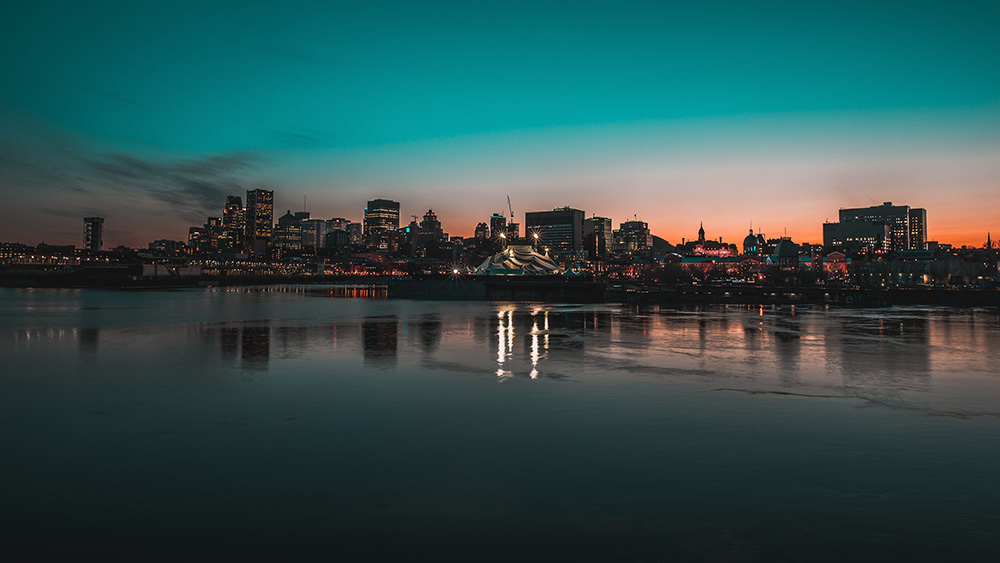On July 1, Canadians from coast to coast will celebrate the Great White North's 150th birthday. And since G Adventures is headquartered in Canada — we were founded in 1990 in Toronto, Ontario — we thought it only fitting that we dedicate a week to weird, wild and wonderful stories about the second biggest country in the world. Happy 150th birthday, Canada!

The northwest Montreal suburb of Villeray-St Michel-Parc Extension is not exactly where you’d expect to see a futuristic silo complex made up of stacked, rounded gray and white cubes. After all, this largely working-class neighbourhood was once known for its limestone quarries and textile factories, and for being home to the biggest dump in Canada.
Founded in 2004, this building — known as TOHU — has won awards for its green design. And the nearby former dumpsite is currently being transformed into a 474-acre (192 hectare) park with lakes, bike lanes, soccer complexes, and gardens (it partly opens this year as part of the city’s 375th anniversary).
But TOHU is best known for another function. It makes Montreal the world capital of circus, which visitors can easily enjoy.
First, a bit about the city’s circus history.

Performers at Cirque du Soleil in Montreal. Photo courtesy of Focka.
The term “circus” is linked to the Romans and their circular arenas, such as Circus Maximus, in Rome. But modern circus as we know it comes from the English, who developed entertainment with clowns in the 1760s, then exported their creation. By 1792, it reached the U.S. via John Bill Ricketts’ travelling shows, and reached Montreal five years later.
Quebec never shook this early “desire for circus,” as Pascal Jacob writes in _Cirque Globa_l. After centuries of juggling, elephants, tightrope walkers, and strong men, circus transformed in the 1970s into nouveau cirque, which was crystallized by Montreal-based Cirque du Soleil a decade later.
This “new circus” meant a shift away from animal-based performances to human-based ones that emphasized at-times complex storytelling. The Québécois version sure caught on globally. As troupes like Cirque du Soleil rose in popularity, animal-based ones declined, eventually falling out of favour so severely that circus mainstay Ringling Brothers ended their 136-year run of animal-based performances last month.
But back to the big question: why is the world’s best circus troupe headquartered in Quebec?

The city of Montreal is a great destination for circus tourism.
Turns out, the government really wanted it. In 1984, provincial leader René Lévesque set aside a million-dollar grant to help Cirque du Soleil off the ground. (And it takes a special sort of government to believe in circus — Vladimir Lenin, of all people, is another example of a circus-loving politician.) As a result of this investment — and of Cirque’s continuous commitment to spectacle and skill — Quebec has changed world circus for good.
And thanks to TOHU, Quebec — and Montreal in particular — is now a destination for circus tourism, and not just for the occasional show. Any time of year, TOHU — which is home to the Ecóle Nationale de Cirque, the only professional circus school in North America — is worth visiting for its “Quel cirque!” exhibit, part of the complex’s collection of 17,000 circus-related artifacts, programs, posters, and sculptures dating from the 16th century to present. It also hosts regular events and annual shows (in early July this year, Cirque Alfonso — a Québécois family circus famed for its beard-heavy lumberjack show — debuts a new one, Tabernak, at TOHU’s one-ring theatre).
The best time for circus in Montreal is July, during the 11-day Complètement Cirque festival (July 6–16 this year). It turns the streets and select small-scale theatres into a flash mob scene of clowns, street performers, and tight-rope productions where rooftops and balconies are taken over by acrobats in bright costumes. Many performers come from around the world, or are graduates of the Ecóle Nationale de Cirque. Nearly 300,000 spectators watched last year.
I attended the festival last year, with my seven-year-old daughter Ruby, and we were both transfixed by tight-rope walkers demonstrating their skills in up-close-and-personal stands along Boulevard St Laurent. And in an old-fashioned circus tent — set amidst a carnival on the TOHU grounds — we watched a French acrobat couple drive into the ring with their car, then pour out a lifetime’s worth emotions while balancing themselves perilously atop poles and wire. There are ticketed shows, which are often the best spectacles overall, but the outdoor, free shows are key to the festival’s overall vibe.
Aside from Cirque du Soleil, the big Montreal circus operations to watch for are Les 7 doigts de la main (which means “the seven fingers of the hand”) and Cirque Eloize, who are based in the city’s former Dalhousie train station, built in 1884. Cirque Eloize’s new “wild west” show Saloon is on a world tour most of the year, but comes back to Montreal from September 20 to 30, then will tour smaller Québécois communities next April and May. Meanwhile, as part of the July festival, 7 Fingers has created an adult-only, three-hour walking tour history of Montreal’s cabaret venues and Prohibition-era brothels on and around Boulevard St Laurent. Vice et Vertu (“vice and virtue”), as it’s called, features 30 performers.
Montreal — and Montrealers — don’t shy away from a good time. And the circus festival is a case study in the city’s anything-goes character — one that surely changed my daughter. Ruby didn’t know she was a circus fan until she visited Montreal. Actually, neither did I.
See Complètement Cirque for more information on festival events around town this summer.
Getting there
Want to check out Montreal, a.k.a. the world's best city for circus tourism (according to us)? G Adventures can get you there. Check out our small group tours to Canada here.























